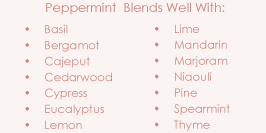Peppermint (Mentha piperita) belongs to a genus consisting of some 20 varieties and hybrids, all containing essential oils in their stems and leaves. Native to the Mediterranean and Western Asia, mint is now grown in temperate regions all over the world with the United States being one of the largest producers. Amongst the many types of mint cultivated, peppermint is the most commercially and medicinally important.
According to hieroglyphics found in ancient temples, mint was used by the Egyptians as a ritual perfume and was an ingredient of the sacred incense kyphi. In ancient Greece and Rome, mint was an everyday part of life, used to scent bath water and bedding.
Today, peppermint oil is widely used in all things including gum, toothpaste, food flavoring and room sprays. The active chemical components in peppermint are menthol, menthone and 1,8-cineole. Menthol is extracted and used extensively in pharmaceutical products. Commercially, the oil is found in various medicines and in confectionary products. In aromatherapy, menthol brings specific properties to the oil, creating an antiseptic, antifungal and antiviral oil with very little toxicity or irritating effects on the skin. The key property of menthone (a ketone) is that it is a good mucolytic and has the ability to ease the secretion of mucus.
According to Daniel Penoel, a medical doctor and aromatherapist,
1,8-cineole has two main pharmacological properties:
- It is an exocrinostimulant for the glands of the respiratory system and digestive organs.
- It is an expectorant because it stimulates mucin-secreting cells and activates the cilia of the respiratory mucous membrane.
Today, many practitioners, doctors and scientists have confirmed these therapeutic values of peppermint and consider it a stomachic, carminative, antispasmodic, tonic and stimulant. It is very good for nervous disorders, vomiting, flatulence and colitis. It is actually used in medicinal products for the treatment of irritable bowel syndrome in the form of enterically coated capsules designed not to dissolve until they reach the large intestine. The antispasmodic properties of this oil have been confirmed in clinical trials, helping to reduce colonic spasms during endoscopy.
Further studies at oncology units in United Kingdom hospitals have found peppermint to be of great value, along with ginger, for the treatment of nausea during chemotherapy treatments. Simply to smell its fresh, clean odor or used in a cold pressed oil and gently applied to the stomach area seems to be most helpful. Peppermint is also used for the general treatment of nausea.
English botanist and herbalist Nicholas Culpepper says of peppermint:
“It is useful for complaints of the stomach, such as wind, vomiting, et cetera, for which there are few remedies of greater efficacy.”
The pungent, stimulating nature of peppermint produces a warming effect on the body; however, the effect of the essential oil is cooling and refreshing. With this in mind, it makes an excellent choice for use in muscle rubs and liniments. As an anesthetic, it relieves pain in muscles and joints, insect bites, bruises and contusions.
With strong antiseptic and expectorant properties, peppermint is useful for the treatment of colds and flu, accompanied by a strong fever, sore throat and headache. I suggest that it is used in base oils together with other antiseptic essential oils such as palmarosa, tea tree, Eucalyptus globulus or Eucalyptus radiata, spike lavender or lemon and applied to the shoulders, neck, throat and lymph nodes under the jaw area. A quick tip to complete the application is to apply a small amount to the soles of the feet and increase penetration by using a hot hair dryer on the soles of the feet, until all the oil has disappeared.
It is excellent for sinus congestion, infection or inflammation and congestive headaches. The classic remedy for headaches is a combination of peppermint, lavender and eucalyptus in a cream or in water and then used in a cold compress. Many headaches are digestive or hepatic in origin, so for a headache accompanied by nausea, peppermint is an excellent choice.
As a mild expectorant, it will also benefit respiratory conditions involving sticky, yellow mucus. It may also be used as an adjunct remedy for chronic bronchitis and bronchial asthma, especially where the digestion is also weak.
To use peppermint for digestive disorders,
"put a couple of drops in an ounce of cold pressed oil such as Calendula oil and gently massage the abdomen in a clockwise direction."
Mind and Spirit
Peppermint oil helps people become clear headed and it refreshes the spirits. It is beneficial for people who find it hard to concentrate. Peppermint’s antispasmodic nature rests partly in its action on the nervous system. As a cephalic oil, it stimulates and awakens the nerves and the brain, enhancing concentration and study. In a blend with rosemary and lemon, this combination will clear the mind, helping with memory retention, all while reducing that feeling of being flustered. However, this blend is not recommended to be used late in the evening as it can cause insomnia or disturbed sleep patterns. Simply diffuse in the room or place a few drops on a tissue to smell periodically. Do not forget to take a few drops into that all important meeting or exam. While not a major tonic for chronic nervous debility, it is useful for mental fatigue especially where an immediate effect is required.
Skin
To use this oil on the skin, it must be used in very low dilutions in a cream or oil – otherwise, it can irritate the skin. It is excellent for reducing any kind of itching or irritation. It reduces heat and inflammation, but at the same time is an anesthetic (meaning it numbs the skin). With that in mind, I highly recommend it for use with oncology patients that, as a result of chemotherapy, have developed very dry skin. Use it in a body lotion or oil such as calendula or make a cool compress and apply it to the affected area. The dryness left untreated can put them into a continuous itch/scratch cycle that can potentially lead to an infection on what is already a highly compromised skin. Peppermint may also be considered for clients with eczema as it can be used as a compress in a very low dilution.
For facial work, I suggest using a good quality peppermint hydrosol. While doing a facial on oncology patients, you can never predict when the skin will flare up during the treatment. You can use the hydrosol as your toner, add it to masks or spray your towels with it. The client will also enjoy the clean, refreshing scent of this product. On a lighter note, do not forget to use it on hot feet in the summer or simply as a light cooling mist for the skin after being at the beach. An important consideration in using peppermint in the spa is to remember that it has a very cooling effect on the body. I often see therapists using this oil in body scrubs and foot scrubs. Personally, having cold feet or feeling cold during body treatments is not always desirable. As an alternative, choose something gently uplifting, warm and comforting for total relaxation.
 Trish Green is a homeopath, certified clinical and medically trained aromatherapist. She recently completed her education in aromatherapy for use in Oncology practice. She is the director of sales and marketing for Eve Taylor North America.
Trish Green is a homeopath, certified clinical and medically trained aromatherapist. She recently completed her education in aromatherapy for use in Oncology practice. She is the director of sales and marketing for Eve Taylor North America.
Want to read more?
Subscribe to one of our monthly plans to continue reading this article.